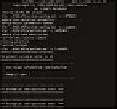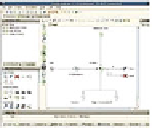Hardware Reference
In-Depth Information
implementations of the platform including low-level refined components written in
Verilog.
Thus, in addition to MULTICUBE tools that will be mentioned later in this study,
the relevant tools used in the platform and that have an impact on this study are the
following:
SCoPE:
SCoPE tool allows to model Real Time Operating Systems (RTOS)
into TLM and to describe the interface between hardware and software. Within
STORM, SCoPE is aimed to allow application SW and MicroC-OS II operating
system over the virtual platform
DS2_SC:
This library is the basis of the platform and contains both introspective
features and communication features. MULTICUBE interface (SCoPE plug-in)
makes use of the API provided by the library in order to inject the parameters
defined by MULTICUBE configuration file in the platform
7.2.2.2
Application of MULTICUBE Tools in the Platform
Figure
7.3
describes the interactions between the different elements that compose
the flow.
The three main entities that interact in DS2 use case are:
STORM platform:
Model of an ITU G.hn MAC level already described in
previous sections
MULTICUBE SCoPE:
Extension of SCoPE tool that has a double objective:
Describe the platform from an XML entry point and implement the interface
between the platform and MULTICUBE exploration tools
modeFRONTIER:
design exploration and analysis tool that controls the whole
process
In the following sections we will comment in detail on the role and particularities of
these tools.
Application SW
SCoPE
modeFrontier
M3
SCoPE
PLUGIN
system_config.xml
Logs
output.xml
STORM























Search WWH ::

Custom Search